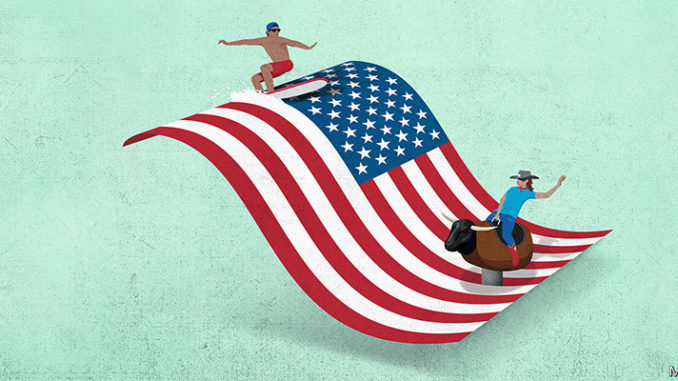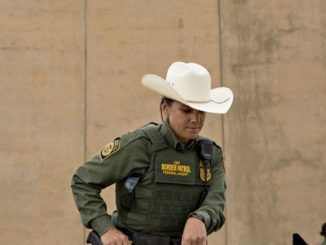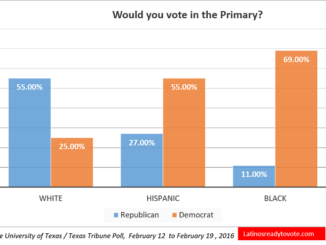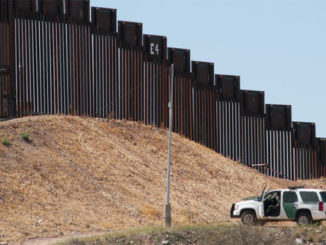
The Economist
America’s future will be written in the two mega-states
In the cable-news version of America, the president sits in the White House issuing commands that transform the nation. Life is not like that. In the real version of America many of the biggest political choices are made not in Washington but by the states—and by two of them in particular.
Texas and California are the biggest, brashest, most important states in the union, each equally convinced that it is the future (see our Special report in this issue). For the past few decades they have been heading in opposite directions, creating an experiment that reveals whether America works better as a low-tax, low-regulation place in which government makes little provision for its citizens (Texas), or as a high-tax, highly regulated one in which it is the government’s role to tackle problems, such as climate change, that might ordinarily be considered the job of the federal government (California). Given the long-running political dysfunction in Washington, the results will determine what sort of country America becomes almost as much as the victor of the next presidential election will.
That is partly a function of size. One in five Americans calls Texas or California home. By 2050 one in four will. Over the past 20 years the two states have created a third of new jobs in America. Their economic heft rivals whole countries’. Were they nations, Texas would be the tenth-largest, ahead of Canada by GDP. California would be fifth, right behind Germany.
Texas and California are also already living America’s demographic future. Hispanics are around 40% of the two states’ populations, double the national average. Both states were early to become majority-minority. In California non-whites have outnumbered whites since 2000, and in Texas since 2005. The rest of the country is not expected to reach this threshold until the middle of the century. California and Texas educate nearly a quarter of American children, many of them poor and non-native English-speakers. Their proximity to Mexico, a country that both used to be a part of, means that as Washington procrastinates on updating America’s immigration laws they must live with the consequences.
At first glance the two states seem as different as a quinoa burger and beef brisket. California is a one-party state in which elected Republicans may soon need the kind of protection afforded to the bighorn sheep. In Texas Republicans dominate the state legislature and all the statewide executive offices: no Democrat has won a statewide race there for more than 20 years. The last Democratic presidential candidate to do so was elected over 40 years ago. Texas has no state income tax. California’s state income tax has a top rate of 13%, the highest in the union. Texas has loose environmental regulations. California is trying to use its economic might to force the rest of the country to adopt more stringent standards on carbon-dioxide emissions. Texas lets its cities sprawl; California has restrictive planning laws.
Take a closer look, though, and Texas looks more like a teenage California. The population of Texas has only recently reached the level California was at in the late 1980s. The Golden State was once a pro-sprawl, low-tax, Republican state, too. Republicans in Austin, who are feeling the first signs of political competition from Democrats in decades, have begun to focus their attention on the state’s shortcomings such as education.
That matters because Texas’s schools, like California’s, perform poorly and its universities are nowhere near as good. In the Texas legislative session which ended last month, politicians focused less on abortion and bathrooms for transgender people, and instead increased funding for public schools. If more Texans managed to vote, they might encourage politicians to do something about the state’s skimpy health-care provision, too.
This might suggest that, as Texas grows up, it will become more Californian. But, ideally, only to a degree—because California has not aged gracefully. It loses Americans each year while Texas gains them. Though the state government has made huge strides—a decade ago it was broke, now it has a healthy surplus and an overflowing rainy-day fund—the state has daunting social problems. Homelessness is just the most visible of them. Unemployment is persistently higher and incomes are more unequal in California than in the land of the ten-gallon hat.
California thinks of itself as a progressive bastion, but it has the highest poverty rate of any state in America. That is partly because regulation makes it so hard to build new homes, pushing housing costs up. It will take more than Google investing $1bn in Bay Area housing to fix that. Texas, meanwhile, lets its cities march outwards as far as they wish. In this limited respect at least, Texas is the more liberal state and California the more conservative one. Americans wanting to move to where housing is cheap, taxes low and work plentiful are voting with their U-Haul trucks and heading to Texas. Just now, Texas has more room than California to innovate and to strike a balance between small government and social support.
In America’s federal system no single state is a national template, and yet each holds lessons for all the others. As America’s largest oil producer, Texas is exceptional. By contrast, despite its faults, California remains a magnet for highly educated migrants and a formidable factory of talent and ideas—which is why it has produced Google, Facebook, Tesla, Uber and Netflix and why, despite grumblings about creeping socialism, the big venture-capital firms and Hollywood studios stay.
America can learn from both of them. That is especially true when the federal government cannot legislate—which today means most of the time—because the ability of states to decide their own fate becomes correspondingly more important.
It is possible to imagine a mash-up of the two mega-states that takes the best of both: a freedom-loving wish to keep government out of people’s private lives, a place that is friendly to business and provides opportunities for people, while also protecting the environment and funding education. California could steal Texas’s expansive approach to housebuilding; Texas could imitate California’s investment in outstanding universities. Americans elsewhere might be less alarmed by demographic change if they visited great cities like Houston, LA and Dallas.
Call this imagined place Texafornia
This article appeared in the Special report section of the print edition of the Economist.



